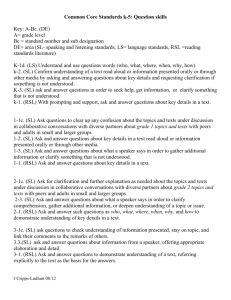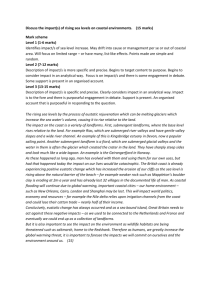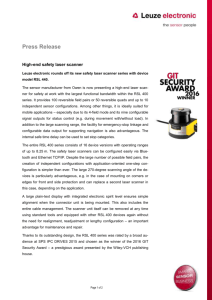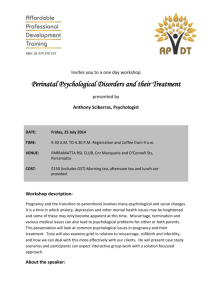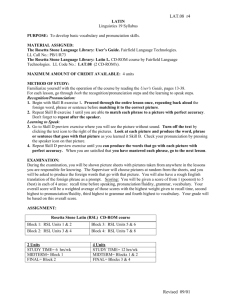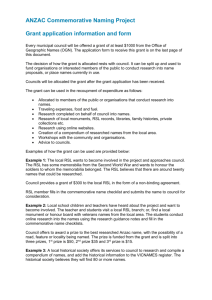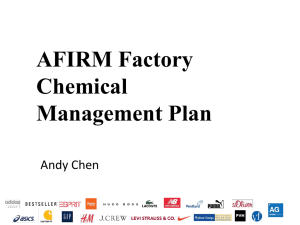Course syllabus (Spring 1998)
advertisement
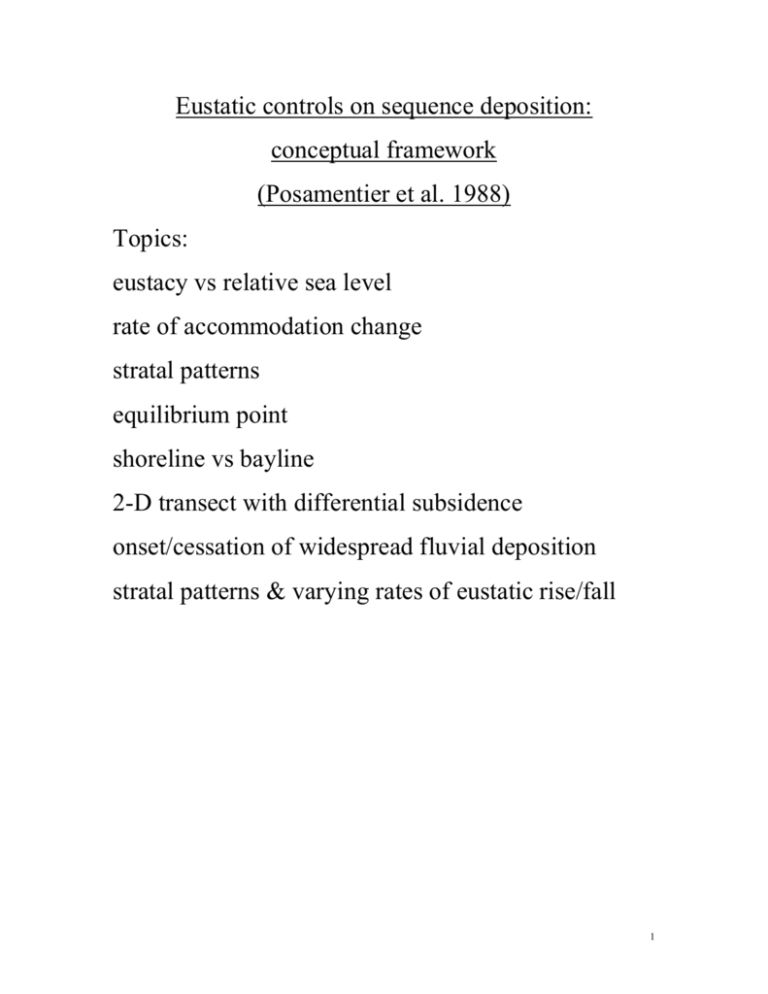
Eustatic controls on sequence deposition: conceptual framework (Posamentier et al. 1988) Topics: eustacy vs relative sea level rate of accommodation change stratal patterns equilibrium point shoreline vs bayline 2-D transect with differential subsidence onset/cessation of widespread fluvial deposition stratal patterns & varying rates of eustatic rise/fall 1 Conceptual models objective: conceptualize relationships between sealevel change & stratal patterns effects of changes in accommodation (space where sedimentation can occur) on basin fill stratigraphy - generally applicable - local factors must be incorporated - predictions of… 2 5 Assumptions of sequence strat. paradigm 1. constant subsidence at any single location 2. subsidence increases basinward 3. shelf/slope/basin margin 4. constant sediment supply 5. eustatic change is curvilinear 3 How can relative sea level (RSL) rise during a eustatic stillstand? RSL change as a function of eustasy & subsidence eustasy = sea-surface relative to a fixed datum RSL = sea-surface relative to a near-surface datum - incorporates local subsidence/uplift (Fig. 8) Does RSL = water depth? water depth = RSL less accumulated sediment How can RSL rise & water-depth decrease? 4 Accommodation = all space made available for sediment to fill (see Fig. 7) function of eustatic fluctuations & subsidence - new space added - old space leftover bound by sea floor & base level graded stream profile (non-marine setting) 5 How does RSL (eustasy & subsidence) change effect stratal patterns? RSL change determines dimension/location of wedge-shaped space between sea surface & sea floor (i.e., accommodation) parasequence stacking pattern depends of rate at which space added & filled - input at landward end - amount of space available - rate of change of new space added 6 What happens if sediment supply is sufficient to aggrade to base level, and rate of addition of new space slows? topset aggradation ____________ topset bypass produces ____________ 7 Assumption #5 eustatic change is curvilinear (see Figure 9) inflection point = greatest rate of eustatic change @ F (falling) inflection points (see Fig. 11), rate of new shelf space added is least rate of aggradation ________________ i.e., thinnest topset beds (per unit time) i.e., rate of progradation increased “shoreline” regression progressively more rapid approaching the F BUT onlap progressively farther landward basinward shift of coastal onlap @ F What kind of parasequence stacking patterns created? 8 @ R (rising) inflection points (see Fig. 12), rate of new shelf space added is greatest maximum addition of new space i.e., thickest topset bed minimum areal extent (for active depocenter) i.e., basinward pinchout migrates landward onlap progressively farther landward maximum landward encroachment of condensed section usually after the R i.e., max. landward extent of condensed sections What kind of parasequence stacking patterns created? 9 One-dimensional model (see Figure 10) rate of RSL change = rate of eustatic change - rate of subsidence if eustasy and datum subside at same rate, the rate of RSL change is ... if eustasy falls more slowly than datum, then RSL ... if eustasy falls more rapidly than datum, then RSL ... 10 Two-dimensional model (see Figure 13) differential subsidence greatest accommodation on outer shelf least on inner shelf At any one time, do different parts of the margin experience the same rate of RSL change? 11 Given: Eustatic-change rate (at any one time) applies to the entire basin But, subsidence rate is dependent upon location We can define… equilibrium point (ep) = point along basin profile where rate of eustatic change = rate of subsidence i.e., point where rate of RSL change is zero “sliding” two-part subdivision of the basin during eustatic change (position of subdivision migrates) seaward of ep, rate of subsidence ___ rate of eustatic fall landward of ep, rate of subsidence ___ rate of eustatic fall 12 ep migrates as rate of eustatic change varies -> @ F inflection point, - ep reaches maximum seaward position -> @ R inflection point, - ep reaches maximum landward position 13 response of sedimentation to an interval of slow eustatic fall (fig. 16) (i.e., type 2 SB) - from T1 - T4, rate of eustatic fall gradually increases - equilibrium point migrates basinward bayline = line between fluvial* & coastal environs * doesn’t include fluvial seds in the delta/coastal plain - does bayline = shoreline? (yes, if no bay/lagoon exist…) - does bayline = point of coastal onlap? (yes if no fluvial sedimentation occurs) - b/c of slow RSL rise prior to T4, the bayline migrates landward - as sediment fills shelfal accommodation (i.e., basinward of the bayline), the resulting stratal pattern will show a gradual landward shift of coastal onlap 14 - rate of landward shift of the bayline decreases as the rate of RSL rise at the bayline decreases approaching T4 15 - after the equilibrium point reaches the bayline at T4, the bayline migrates basinward with the equilibrium point - when the bayline migrates basinward across a surface of low relief, subaerial new space is added - lateral (basinward) shift of graded stream profiles @ T4 - T6 - widespread fluvial aggradation as streams attempt to maintain a graded profile 16 - fluvial deposition ceases when the equilibrium point/bayline reaches its basinward-most position @ the F inflection point - once fluvial deposition ceases, the point of coastal onlap abruptly shifts basinward to the bayline - deposition is once more restricted to the wedgeshaped space between the sea floor and the sea surface (T6 to T8) 17

